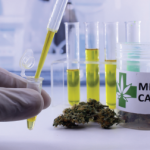Cannabis for Medical Use
Cannabis has an herbal form and a medical formulation. The medical formulation is a regulated pharmaceutical product with established good manufacturing practices, as well as set dosages, indications and contraindications. The majority of cannabis studies focus on pharmaceutical products rather than herbal cannabis. This distinction makes it hard to collectively understand the effects of herbal cannabis.
“Our patients are using the herbal product, and we truly don’t know the ideal dosing. We don’t know the ideal combination. We don’t know the ideal strain,” Dr. Fitzcharles says.
She notes that physicians focusing on cannabis for their patients should use the term medical cannabis instead of marijuana, which has recreational connotations.
Cannabinoids work on the body’s endocannabinoid system, which helps regulate several functions in the body, including pain. The two most studied molecules in cannabis are tetrahydrocannabinol (THC) and cannabidiol (CBD). However, other molecules mixed with the plant contribute to its potential benefits for pain or other medical conditions. The way the plant is grown may also affect its utility, such as where it was grown, lighting and more.
Pain Perception & Rheumatology
With her dual background in rheumatology and pain management, Dr. Fitzcharles became involved in researching cannabis as it became more accessible in Canada. Her studies have found that pain sometimes endures in rheumatological disease even under good circumstances.
“We know that even with beautiful control, many patients still have a remaining pain or secondary fibromyalgia, or what we now call a component of nociplastic pain,” she says.
Nociplastic pain may be out of proportion to perceived tissue damage and does not respond to traditional treatments, such as opioids and anti-inflammatory drugs. These concerns are why physicians are researching other treatments, such as anti-epileptic therapies, some forms of anti-depressants and cannabinoids.
One challenge with cannabis is the lack of a large body of research, such as randomized controlled trials and systematic reviews, that other traditional treatments have to support its use, Dr. Fitzcharles notes. More research exists on medical formulations and very little on herbal cannabis, particularly for rheumatology.
“There have been [fewer] than 200 rheumatology patients studied in [randomized controlled trials] looking at the effects of pharmaceutical cannabinoids. There have been 58 patients with rheumatoid arthritis and a handful of patients with fibromyalgia and a few patients with low back pain,” Dr. Fitzcharles says.
This lack of data makes it harder to truly understand the effectiveness of herbal cannabis beyond cohort studies, dispensary-sponsored studies and patient self-reporting.



